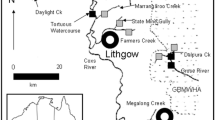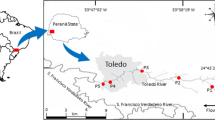Abstract
Benthic invertebrate communities have been known to change due to impacts from nutrient-rich industrial outputs, such as those from pulp and paper, sewage-treatment plants, or aquaculture. Fish-processing plants have been recognized as contributors of large volumes of nutrient rich effluent to marine and estuarine environments, but their effect on benthic invertebrate communities is unknown. Benthic invertebrates and sediment samples were obtained from marine sampling stations at 0-, 10-, 30-, and 100-m distances from two fish-processing outfalls in Atlantic Canada. Sediment grain size, total organic carbon (TOC), ammonia, sulphide, and redox, as well as invertebrate abundance, density, taxa richness, Simpson’s Inverse Diversity Index, Bray-Curtis Index of (%) Similarity, and the AZTI marine biotic index (AMBI), were determined for all sampling sites. Results from this study illustrate that taxa richness and density significantly increased as distance from the outfall discharge increased. In our study, TOC was only significantly correlated to AMBI but not to the other benthic invertebrate assemblage descriptors calculated in this study (invertebrate density, taxa richness, Simpson’s Inverse Diversity Index). The study results suggest that taxa richness and density may be affected by effluent from fish-processing plants.

Similar content being viewed by others
References
Albayrak S, Balkis H, Zenetos A, Kurun A, Kubanc C (2006) Ecological quality status of coastal benthic ecosystems in the Sea of Marmara. Mar Poll Bull 52:790–799
AMEC (2003) Management of wastes from fish processing operations. Report submitted to National Programme of Action Atlantic Regional Team. Environment Canada–Atlantic Region
Ansaria ZA, Ingolea BS, Parulekara AH (1986) Effect of high organic enrichment of benthic polychaete population in an estuary. Mar Poll Bull 17(8):361–365
Benson A (2008) Littorina littorea. USGS nonindigenous aquatic species database, Gainesville, FL. Available at: http://nas.er.usgs.gov/queries/FactSheet.asp?speciesID=1009. Revision date: 8/20/2007. Accessed 20 Dec 2011
Borja A, Muxika I (2005) Guidelines for the use of AMBI in the assessment of the benthic ecological quality [correspondence]. Environ Pollut 50:787–789
Borja A, Muxika I, Franco J (2003) The application of a marine biotic index to different impact sources affecting soft-bottom benthic communities along European coasts. Mar Poll Bull 46:835–845
Borja A, Dauer DM, Diaz R, Llanso RJ, Muxika I, Rodriguez JG et al (2008) Assessing estuarine benthic quality conditions in Chesapeake Bay: a comparison of three indices. Ecol Ind 8:395–403
Brunel P, Bossé L, Lamarche G (1998) Catalogue of the marine invertebrates of the estuary and Gulf of Saint Lawrence. Can Spec Pub Fish Aquat Sci 126:408
Callier MD, McKindsey CW, Desrosiers G (2008) Evaluation of indicators used to detect mussel farm influence on the benthos: two case studies in the Magdalen Islands, Eastern Canada. Aquaculture 278:77–88
Callier MD, Richard M, McKindsey CW, Archambault P, Desrosiers G (2009) Responses of benthic macrofauna and biogeochemical fluxes to various levels of mussel biodeposition: an in situ “benthocosm” experiment. Mar Poll Bull 58:1544–1553
Carvalho S, Gaspar MB, Mora A, Vale C, Antunes P, Gil O et al (2006) The use of the marine biotic index AMBI in the assessment of the ecological status of the Obidos lagoon (Portugal). Mar Pollut Bull 52:1414–1424
Chivilev S, Ivanov M (1997) Response of the arctic benthic community to excessive amounts of non toxic organic matter. Mar Pollut Bull 35:280–286
Clarke KR, Gorley RN (2006) PRIMER v6: user manual/tutorial. PRIMER-E, Plymouth
Colwell RK (2009) EstimateS: Statistical estimation of species richness and shared species from samples. Version 8.2. User’s Guide and application available at: http://purl.oclc.org/estimates
Ernst B, Hawkins V, Tay KL (1982) Investigation of the cause and extent of PCB contamination of Petit-de-Grat Harbour Nova Scotia. Environment Canada EPS-5-AR-82-2
Fahim FA, Fleita DH, Ibrahim AM, El-Dars FMS (2001) Evaluation of some methods for fish canning wastewater treatment. Water Air Soil Pollut 127:205–226
Gao QF, Cheung KL, Cheung SG, Shin PKS (2005) Effects of nutrient enrichment derived from fish farming activities on macroinvertebrate assemblages in a subtropical region of Hong Kong. Mar Pollut Bull 51:994–1002
Grall J, Glémarec M (1997) Using biotic indices to estimate macrobenthic community perturbations in the Bay of Brest. Estuar Coast Shelf Sci 44:43–53
Hilbig B, Blacke JA (2000) Long-term analysis of polychaete-dominated benthic infaunal communities in Massachusetts Bay. USA. Bull Mar Sci 67(1):147–164
Jamieson BL, Goncalves AA, Gagnon GA (2009) Toxicology evaluation of Atlantic Canadian seafood processing plant effluent. Environ Toxicol 25:137–146
Jiménez EI, Garcia VP (2003) Relationships between organic carbon and total organic matter in municipal solid wastes and city refuse composts. Bioresour Technol 41:265–272
Kilgour BW, Somers KM, Barton DR (2004) A comparison of the sensitivity of stream benthic community indices to effects associated with mines, pulp and paper mills and urbanization. Environ Toxicol Chem 23(1):212–221
Lalonde BA, Ernst W (2010) Polybrominated diphenyl ethers (PBDEs) concentration in sediments located in the vicinity of fish plant effluent outfalls in the Maritimes. Bull Environ Contam Toxicol 84:322–325
Lalonde BA, Garron C, Ernst W (2007) Characterization and toxicity testing of fish processing plant effluent in Canada. Environment Canada. Surveillance Report EPS-5-AR-07-03
Lalonde BA, Jackman P, Doe K, Garron C, Aubé J (2009) Toxicity testing of sediment collected in the vicinity of effluent discharges from seafood processing plants in the Maritimes. Arch Environ Contam Toxicol 56:389–396
LECO (1991) Carbon in soil, rock, limestone and similar material. Application Bulletin 203-601–224
Lenihan HS, Peterson CH, Kim SL, Conlan KE, Fairey R, McDonald C et al (2003) Variation in marine benthic community composition allows discrimination of multiple stressors. Mar Ecol Prog Ser 261:63–73
Lowell RB, Ribey SC, Ellis K, Porter EL, Culp JM, Grapentine LC, et al. (2003) National assessment of the pulp and paper environmental effects monitoring data. National Water Research Institute, NWRI Contribution No. 03–521
Lu L, Grant J, Barrell J (2008) Macrofaunal spatial patterns in relationship to environmental variables in the Richibucto Estuary, New Brunswick, Canada. Estuar Coasts 31:994–1005
Magni P, Tagliapietra D, Lardicci C, Balthis L, Castelli A, Como S et al (2009) Animal sediment relationships: Evaluating the “Pearson-Rosenberg paradigm” in Mediterranean coastal lagoons. Mar Pollut Bull 58:478–486
Mallet AL, Carver CE, Landry T (2006) Impact of suspended and off-bottom eastern oyster culture on the benthic environment in Eastern Canada. Aquaculture 255:362–373
Miron G, Landry T, Archambault P, Frenette B (2005) Effects of mussel culture husbandry practices on various benthic characteristics. Aquaculture 250:138–154
Morris L, Keough MJ (2003) Variation in the response of intertidal infaunal invertebrates to nutrient additions: Field manipulations at two sites within Port Philip Bay, Australia. Mar Ecol Prog Ser 250:35–49
Muxika I, Borja A, Bonne W (2005) The suitability of the marine biotic index (AMBI) to new impact sources along the European coasts. Ecol Ind 5:19–31
NovaTec Consultants, Inc. (1994) Guide for best management practices for process wastewater management at fish processing plants in British Columbia. Fraser River Action Plan
Parker WR (2008) Sediment quality in the Lower Miramichi River Estuary and Miramichi Bay—Results of a 2007 survey. A report to The Miramichi River Environmental Assessment
Pearson TH, Rosenberg R (1978) Macrobenthic succession in relation to organic enrichment and pollution of the marine environment. Oceanogr Mar Poll Ann Rev 16:229–231
Plante F, Courtenay S (2008) Increased oxygenation of sediment in Lameque Bay (New Brunswick) following removal of algae and reduction of inputs from a seafood processing plant. Can Tech Rep Fish Aquat Sci 2805:36
Ramey PA, Snelgrove PVR (2003) Spatial patterns in sedimentary macrofaunal communities on the South coast of Newfoundland in relation to surface oceanography and sediment characteristics. Mar Ecol Prog Ser 262:215–227
Roy Consultants Ltd., NATECH Environmental Services, OCL Group Management Consultants (2002) Lamèque Bay Environmental Management Study
Saunders JE, Al Zahed KM, Paterson DM (2007) The impacts of organic pollution on the macrobenthic fauna of Dubai Creek (UAE). Mar Pollut Bull 54:1715–1723
Savage C, Elmgren R, Larrson U (2002) Effects of sewage-derived nutrients on an estuarine macrobenthic community. Mar Ecol Prog Ser 243:67–182
Shaw KR (1998) PEI benthic survey – 1998. Tech. Rep. Environ. Sci. 4:75p
Shin PKS, Lam NWY, Wu RSS, Qian PY, Cheung SG (2008) Spatio-temporal changes of macrobenthic community in sub-tropical waters upon recovery from eutrophication. I. Sediment quality and community structure. Mar Pollut Bull 56:282–286
Sutherland TF, Levings CD, Petersen SA, Poon P, Piercey B (2007) The use of meiofauna as an indicator of benthic organic enrichment associated with salmonid aquaculture. Mar Pollut Bull 54:1249–1261
Thériault MH, Courtenay SC, Godin C, Ritchie WB (2006) Evaluation of the Community Aquatic Monitoring Program (CAMP) to assess the health of four coastal areas within the southern Gulf of St. Lawrence with special reference to the impacts of effluent from seafood processing plants. Can Tech Rep Fish Aquat Sci 2649
Usydus Z, Bykowski PJ (1999) Treatment of wastewater from fish processing factories. Bull Sea Fisheries Institute 1(146):71–84
Van Guelpen L, Pohle G, Vanden Berghe E, Costello MJ (2005) Marine Species Registers for the North Atlantic Ocean. Available at: http://www.marinebiodiversity.ca/nonNARMS/, version 1.0/2005. Accessed 20 Dec 2011
Walker SL, Hedley H, Porter E (2002) Pulp and paper environmental effects monitoring in Canada: an overview. Water Qual Res J Canada 37(1):7–19
Walsh ME, Chaulk M, Gagnon GA (2004) Preliminary assessment of effluents generated by seafood processors in the Atlantic Region. Centre for Resource Studies, Halifax
Walton A (1978) Section 5. Physical analysis. In: Walton A (ed) Methods for sampling and analysis of marine sediments and dredged materials. Ocean Dumping Report 1. Department of Fisheries and the Environment, Ottawa
Wasave SM, Kulakarni GN (2004) Surimi wastewater characteristics and its toxicity to the fingerlings of Tilapia, Oreochromis mossambicus. Pollut Res 22(2):125–130
Wells FE (1976) The relationship between environmental variables and the density of the mud snail Hydrobia totteni in a Nova Scotia marsh. J Moll Studies 44(1):120–129
Wells PG, Schneider JR (1975) Characteristics of fish plant wastes in Nova Scotia and their effects on coastal bays III: toxicity studies. Environment Canada. EPS-8-AR-75-4
Acknowledgments
We thank Bertin Gauvin from La Coallition pour la Viabilité de l’Environnement de Shippagan et des Îles Lamèque et Miscou and Simon Courtenay from Fisheries and Oceans Canada at the Canadian Rivers Institute for obtaining the sediment samples. We also thank Arenicola Marine for the taxonomy work.
Author information
Authors and Affiliations
Corresponding author
Rights and permissions
About this article
Cite this article
Lalonde, B.A., Ernst, W. Analysis of Benthic Invertebrate Communities as a Function of Distance from Two Fish-Processing Plant Effluent Discharges in New Brunswick, Canada. Arch Environ Contam Toxicol 63, 45–53 (2012). https://doi.org/10.1007/s00244-012-9749-4
Received:
Accepted:
Published:
Issue Date:
DOI: https://doi.org/10.1007/s00244-012-9749-4




